
I’m on the bow of the boat, bag over my camera, when the rain falls. We’re drifting over Alleppey’s backwaters, fed by the Arabian Sea and 38 rivers from across Kerala, southern India. 900km of waterways connect to each other, irrigating rice paddy fields and forming a natural human ecosystem built by the hands of India’s people in kinship to the surrounding landscape. It is a testament to the power of human nature — to live in accordance with the land and its diverse inhabitants.
At age 17, I saved every dollar I had, drawn to India as a beginner photographer. I’ve been back here many times since, always driven by a personal project and inspired by the people of India. Today those same people have now brought me back. This is my first commissioned work in India and it’s a tourism campaign for Kerala.
It’s an emotional milestone to everything I’ve done here before. The recognition that a local Indian advertising agency and their client- the state of Kerala itself, acknowledge my work enough to trust me with this monumental project is truly a blessing. We’re here to do more than bring Kerala’s rich reputation as a traveler’s haven back to the forefront. We’re here to help restore the residual economy back to its glory before the devastating floods of 2018.
Nearly 500 people lost their lives in the flooding and the damage inhibited much of Kerala’s economic relation to tourism and travel. I am humbled by the people’s resolve, the resiliency of nature to rebuild, and the abundance of stories that fill every corner of Kerala. From the interconnected backwaters, the forests of Wayanad, the beaches of Alleppey, the temples of Thrissur, and the streets of Kochi—Kerala is right the place with the right traditions to embody what we’ve come to know as Human by Nature.
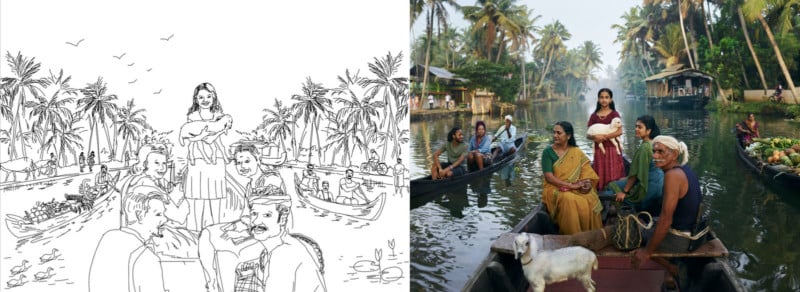
I look down at the black and white sketches that Shelton and Unni, the creative directors from Stark, prepared. “You know you’re crazy, right?” I tell them, looking at the complicated group shots they envision. There are so many subjects, so much going on in every frame, I am scared we won’t be able to pull it all off. But their confidence in the production is contagious, and we decide just to go for it.
We will be photographing 5 main advertising images, each representing a unique environment in Kerala: the forest, temple, streets, seashore, and backwaters. Beyond these main complicated images, the creative team agrees that we can work even harder and also shoot other environmental portraits of the subjects that make up each frame.
At the heart of this photo series is the convergence of different cultures co-existing within a single place. Tourism is built around the basic lifestyle that Kerala lives in, instead of being created as its own entity. Therein lies the draw. I was not only encouraged, but also inspired by our clients (now friends) within their devotion to their homeland. In the series of group compositions, we were able to photograph people of varying walks of life true their role.
The travelers are included, yet are not prominent. They are a part of the landscape, but they take a back seat and a blurry composition in conjunction to the local people who exist in this natural aesthetic as effortlessly as you or I live in our own homes. It’s an ode to what travelers are looking for in Kerala: real life. They want to observe and assimilate naturally to the rich culture and color instead of overtaking it. In a place like Kerala, one does not need to construct entertainment and beauty. It’s already there, original and wild all the same.
![]()
The Forest
In the forests of Wayanad, a blanket of fog followed us into the lush forest. Dusk broke and scattered the light between ancient tree-lines. We trekked along elephant tracks through some of the last remaining tropical evergreen rain forests high in the mountains. I was able to highlight real roles people lead in these lands. Around here several tribes make their living in and through the forest.
We highlighted farmers who have migrated to these fertile lands and rangers that tend to this wildly diverse landscape. There are school children in the background taking what would be a common route to school each day. The forest is their home, education — their life. Kerala has the highest literacy rate in all of India precisely because of the economic and social developments that have afforded every demographic the opportunity to grow through education and rising equality. There is a whole ecosystem of interdependent coexisting plants, animals, and people that make this land what it is.
A significant aspect of this shoot was scouting. I was given access to remote villages to first introduce ourselves before shooting. I was invited into local homes and met with those operating inside the forest walls to achieve a lay of the land before we organized the detailed compositions. We were guided by locals as to not disrupt or impede on the resident wildlife. To create the atmospheric fog we wrangled incense dispensers in place of fog machines. This involved quite a bit of running to account to the wind change, yet also mirrored the work ethic of our crew to see the vision through. The photoshoot itself became somewhat of a ceremony and that in turn made the process fun. Locals came by herding animals to catch a glimpse of what this organized madness.
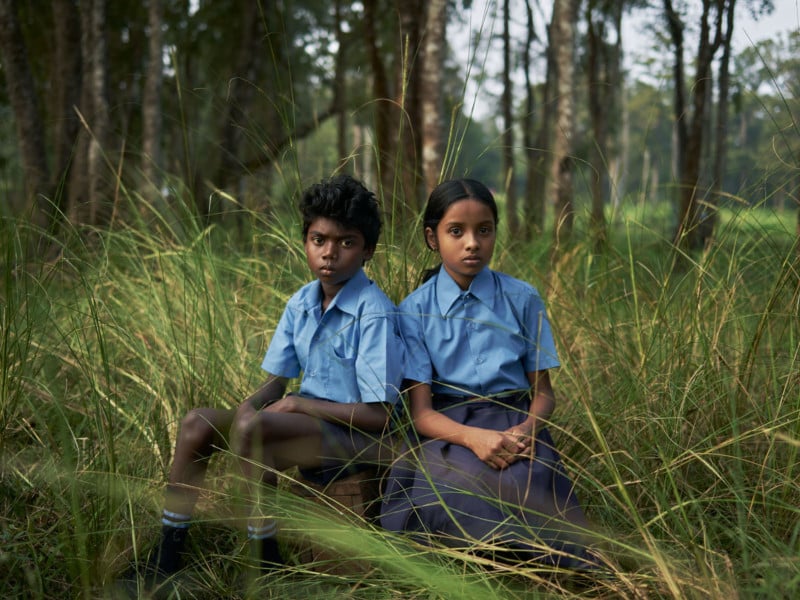
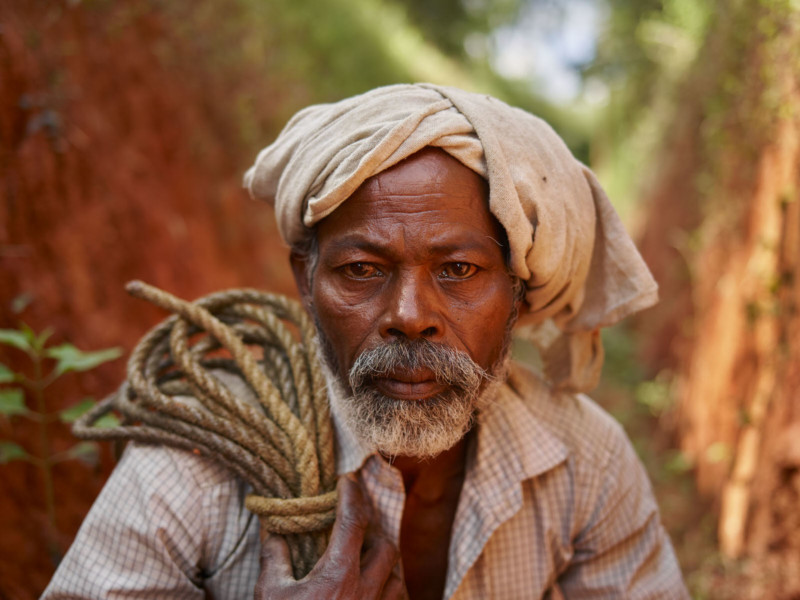
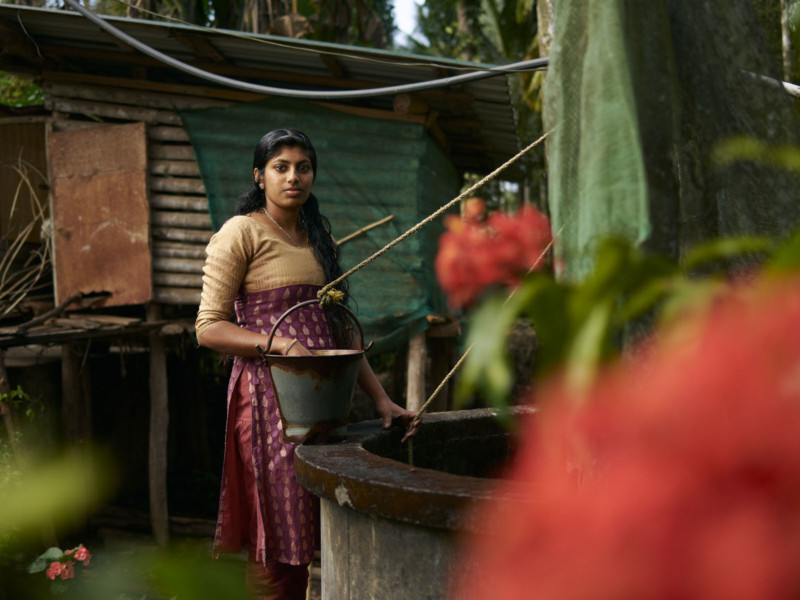
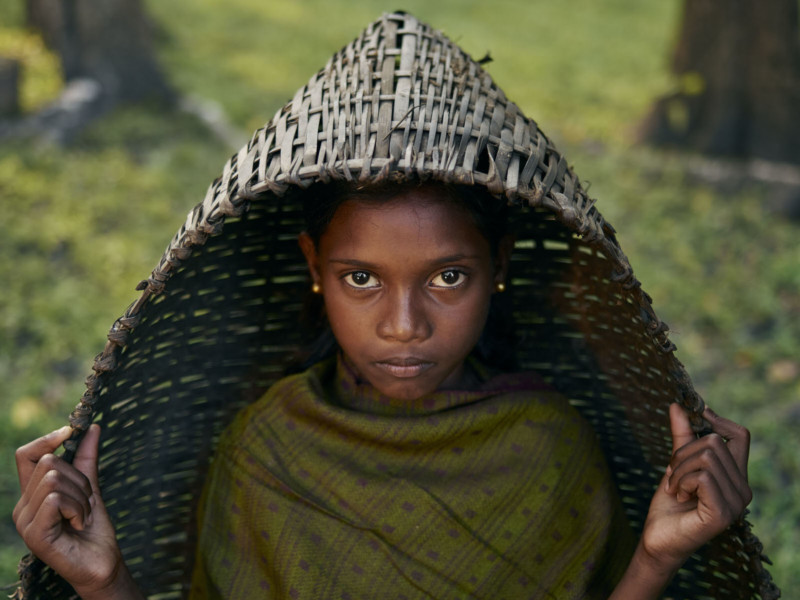
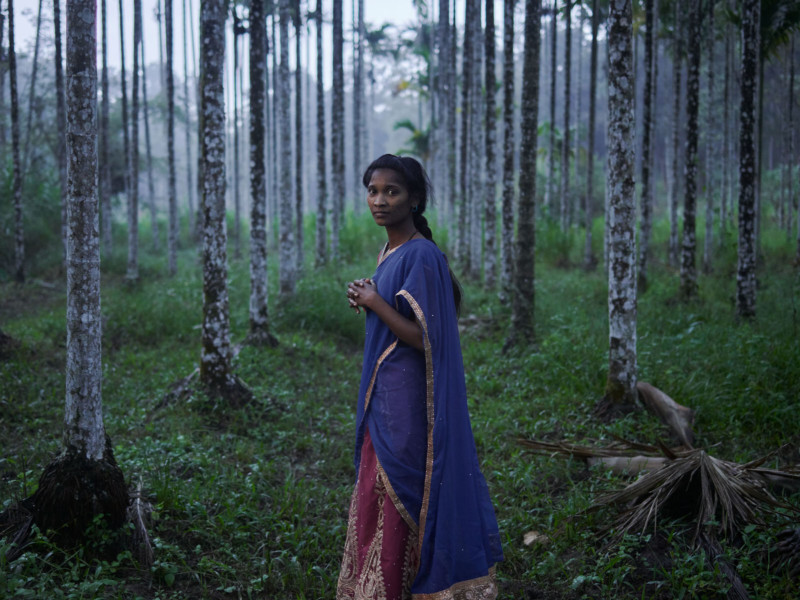
Temple
Our crew traveled further still into the villages of Thrissur, hailed as the Cultural Capital of Kerala within its prolific history of spiritual and religious learnings. Thrissur’s many temples stand as landmarks to this cultural sanctum. At the forefront of the portrait is a Tiger man, or Pulikkali (play of the tigers). This painted tiger folk art has been preserved for centuries within the renowned Thrissur celebration Onam, the Harvest festival.
Aside from the group photographs, I did a few more intimate sittings, including one of the Tiger man getting painted by Francis, a local artist. I wanted to further highlight the intrinsic details that went into these shoots and the ceremonial glamour of Thrissur by honing into the individual players that make these enormous celebrations thrive throughout time. There were many moving parts in this composition.
One major part was the elephant, local to the land, and largely a part of festival culture. It was important to me to respect the animal by minimizing the time and movement within the photograph. She was photographed as the only composite in the image- not in the actual rice field. We took no more than 20 minutes of her time and brought our set up to her, instead of the other way around.
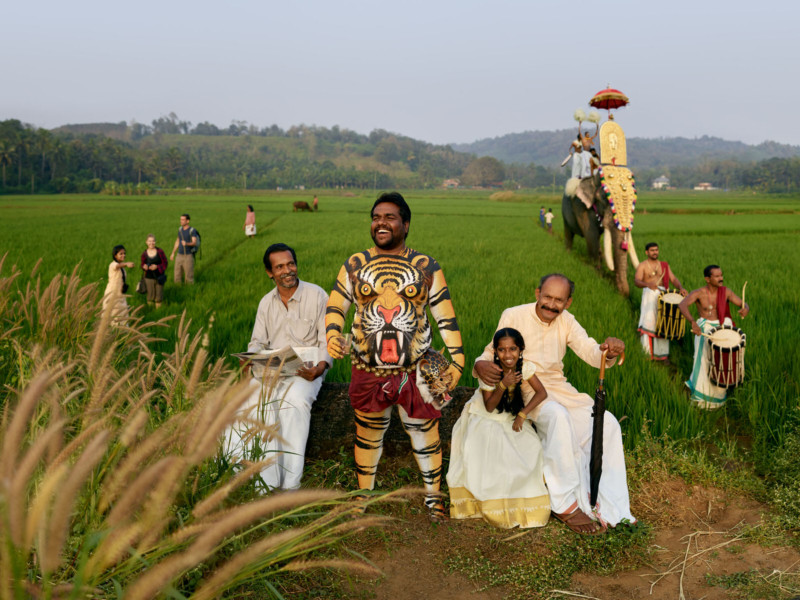
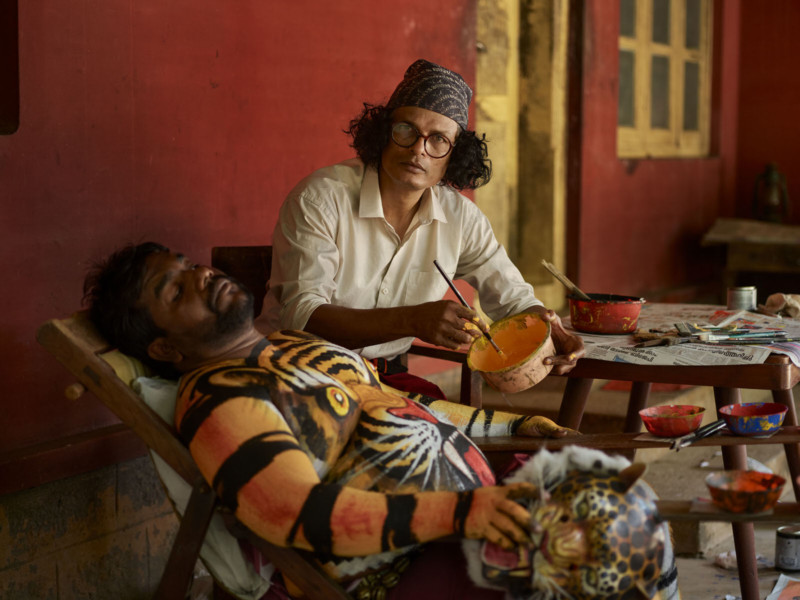
![]()
![]()
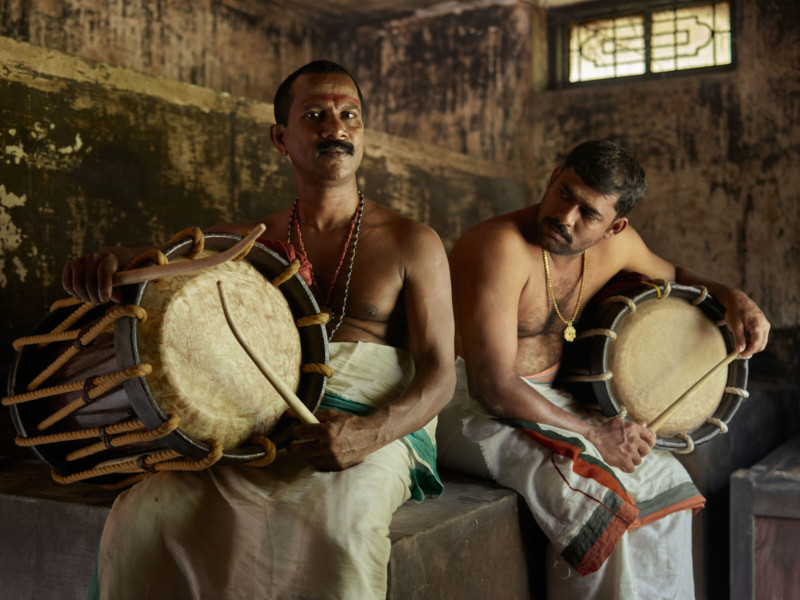
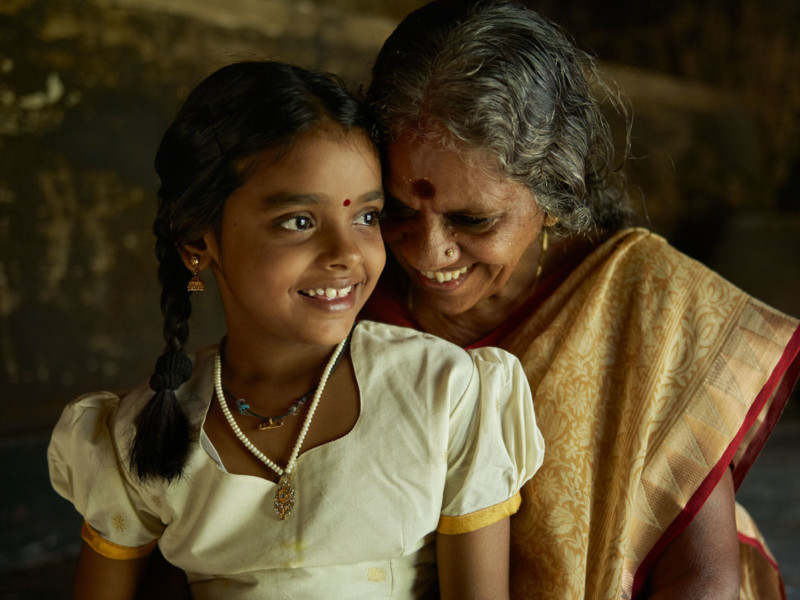
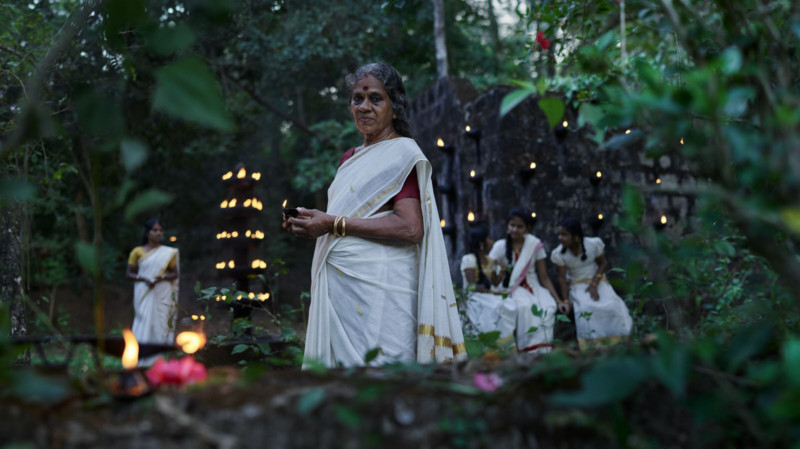
In the spirit of India, we were humbly invited to another Hindu celebration after wrapping the day’s shoot. The temple was adorned with candles, singing, and we got a first-hand glimpse of puja — the loving offering of light, flowers, and water or food to the divine. The closeness we found within the family of our local crew and clients grew upon each experience we were afforded.
![]()
Streets
Fort Kochi is one of those red-letter places, not stuck in time, but thriving in between multiple eras of modernism and a colorful past. Once the center of the Indian spice trade, Kochi brims with the culture of the Chinese, the Jewish, the Arabian and Syrian influence brought by trade and planted into everyday life. The markets are full of remnants of these international provinces in Kerala. The streets are busy with commerce: fresh fish grilled on the spot and a friendly disposition of the locals towards visitors far and wide. I’ve rarely encountered such a place where people are so open to my camera, spurred by a deep appreciation for the cinematic and photographic arts born out of the rich history of Bollywood.
We motorbiked between street vendors and livestock, canals to our left, the sea to our right. At midday, we paused for traditional southern food washed down with masala tea and lime juice. The nights fell into an unusual, yet desirable, quiet contrasted by the bustling day of intense shooting and awkward shouting from behind my camera. “Action! action! action! Someone try to get that pigeon back in the frame! Do we have any bread?!”
Our crew is now getting exhausted, but we are up before the sun and the sounds of Kochi. It’s a beautiful time in the city — the calm we share with only the earliest of the fishermen. It was important for us to get organized before the rest of Kochi awoke and filled the empty spaces we needed to shoot. I photographed our subjects right in the center of one of these most vibrant streets. Between shots, we had an elaborate, yet somewhat chaotic scheme to aid the flow of traffic. This was only possible through the locals generally appreciation for production and the cast and crew’s commitment to what we were striving for.
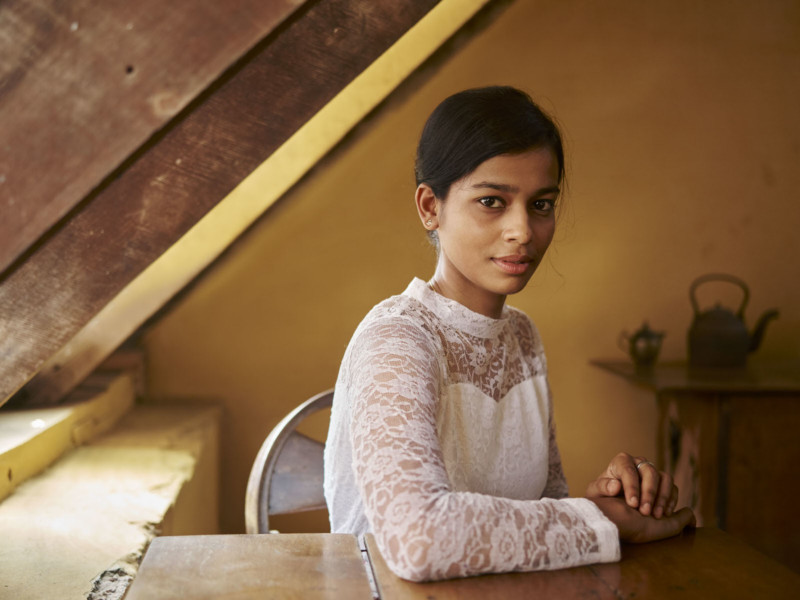

Continuing within the open nature of the shoot, walking through the warm streets, I came across another scene that is distinctly Kerala- a communist youth center of DYFI, tucked modestly in between residential buildings, emitted the soft red glow of a neon red hammer and sickle. I met with a group of these young communists, who were more than eager to invite us in. In fact, the elections were currently underway in Kerala with the Communist Party of India high on the ballot. Kerala is the leading state in India with such a thriving communist presence born out of the anti-colonial sentiment and class struggle.
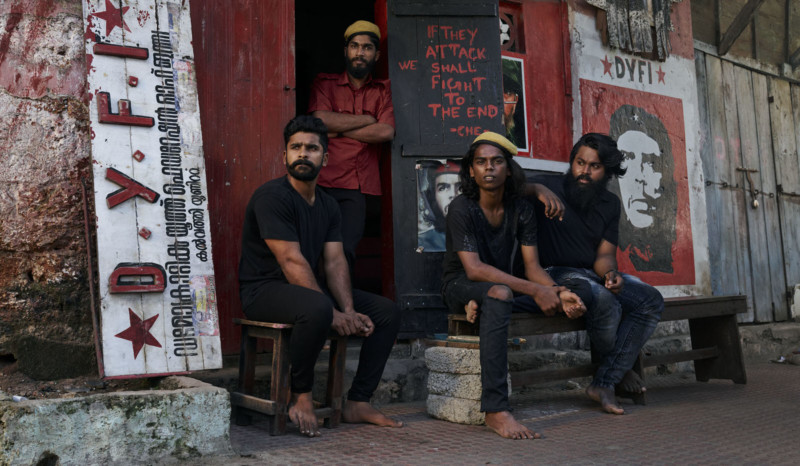
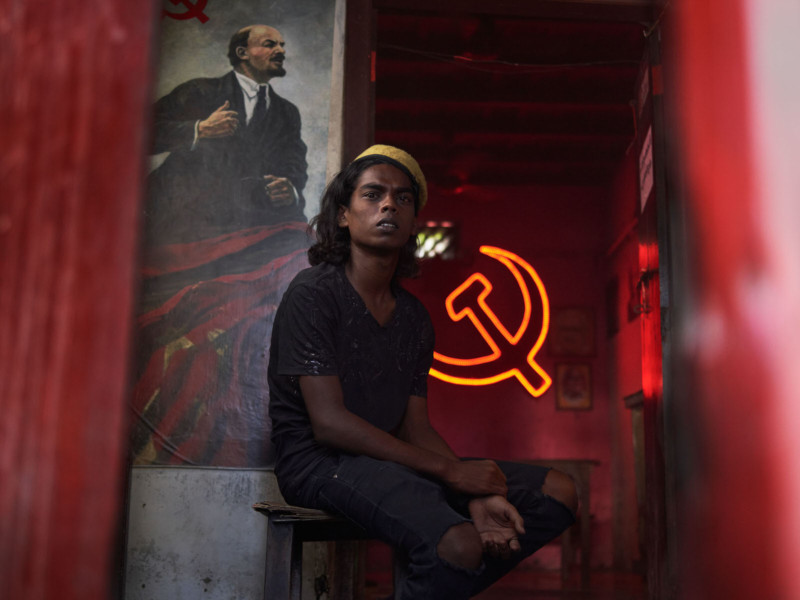
![]()
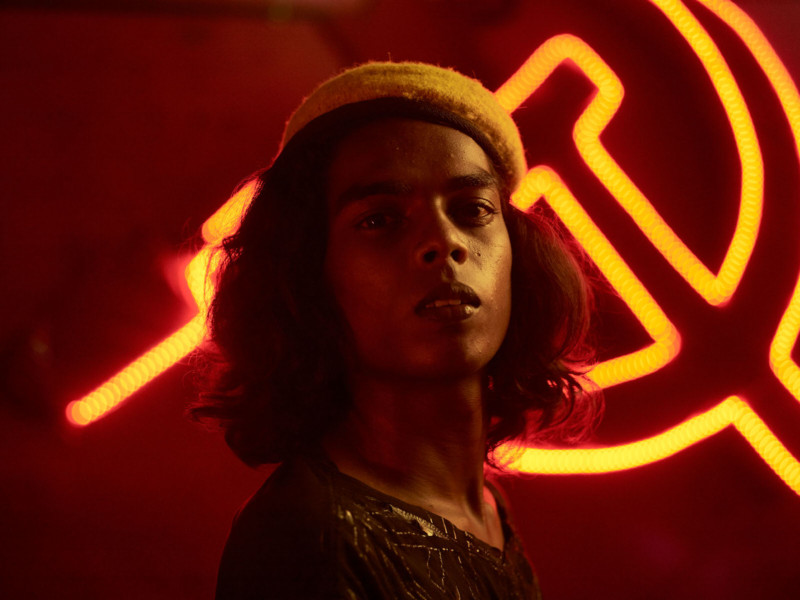
Seashore
It rained endlessly in the middle of August, Kerala 2018. Rivers flowed into the streets, into homes. Kerala, surrounded and dependent on the various channels of water, was suddenly consumed. It was then that authorities put out the local call. They needed help. And there was one demographic that rose to the occasion: the fishermen of Kerala. It is estimated that of the population that needed to be extricated from the flood, volunteer fishermen rescued a dominant 70 percent, with the remaining rescues by organized forces. This notion really elevated our photograph of the seashore to a higher intention. The stakes were made higher by the devastation of Kerala to the monsoons.
In this image, I wanted to show the sea shore restored to pre-monsoon conditions, while also highlighting the people who would become modern heroes to Kerala. These fishermen left their villages and rescued those in the city without means of escaping the floods. There was no system in place for this. They simply acted upon necessity and bravery. This is the human by nature quality at its finest declaration. It’s the people of Kerala united across classes and pathways to ensure each other’s survival and growth.
On the day of the shoot, again the local people and fishermen proved their resolve. It took a convoy of nearly 20 men to wrangle the boat into position for our photograph. Cast and crew chipped in to the well-oiled machine needed for this composition. With a crowd of excited onlookers, we accomplished this feat just as the sun set behind the horizon. In Kerala, the beach-side is more of a way of life, a co-existent ecosystem of its own. It’s commerce and history, and now a monument to the local human fortitude in the wake of disaster.
![]()
Backwaters
I arrive to set by motorboat, moving through dark waters in nearly pitch black. We compose the photograph, carefully reconstructing the prior day’s efforts. As morning breaks, locals bathe in the canals. They clean their laundry, slipping into the water that is their front yard, hanging the colorful garments in front of equally colorful homes. Instead of cars parked out front, they have boats, which carry uniformed children to school, adults to work, and food to the water-side markets. The composition is full, meticulous in the recreation of what is the backwaters reality. Its normal life on not so normal terms. Our featured baby goat quickly became a crew favorite, with everyone taking turns feeding him when he was hungry. Our talented local art director, Gopal Ji, formed the closest bond with the baby goat, and later adopted it.
![]()
At the end of the shoot day, we bathe in the water and drink fresh coconut toddy, getting slightly drunk together, commemorating a job well done. The motorboat takes us to a houseboat for the night, where I find myself on the bow watching the storm clouds collect overhead. The sky breaks with the rain. I sit with my assistants Brian and Will, and we watch the downpour. I photograph the last light for myself, as the tropical rain stops as quickly as it comes. Boats continue down the river, lit now by warm bulbs overhead. The water stills and the musical sound of the nearby Hare Krishna encampment is projected over the water. We feel human by nature, and we fit every hippy stereotype of foreigners in India both literally and spiritually here in the magical but somehow real world of Kerala.
About the author: Joey L. is a Canadian-born photographer and director based in Brooklyn, New York. Since the age of 18, Joey’s work has been consistently sought out by a number of prominent advertising clients, including the National Geographic Channel, U.S. Army, Lavazza for their 2016 calendar, Canon, Summit Entertainment, and many others. You can find more of his work on his website, Instagram, Twitter, and Facebook. Joey’s lighting and Photoshop tutorials can be viewed at LearnFromJoeyL.com. This article was originally published here.
Credits: Client, Kerala Tourism: Rani George, P Balakiran. Stark: Shelton Pinheiro, Sree Shanker, Unni Krishnan, Manoj I S, Prem Mathew, Vinesh Kumar, Ajith Gopinath, and Anu Praveen. Production: Rafik T.M, Cilara Jacob, Gopal Ji, Giuseppe Ceroni at Sudest 57
Lighting and DIT: Brian McGuffog, Will Martinez. Post-production: Joey L., Ryan Cleary

